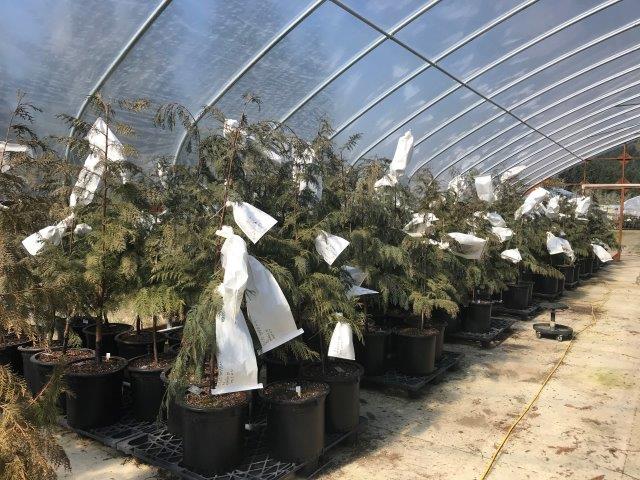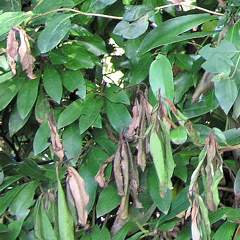
At the annual meeting of the National Plant Board in July, I learned that two new Phytophthora species have been detected in the United States. Questions remain about how each arrived.
- Phytophthora austrocedrii
This species was detected in a nursery in Oregon, then traced back to a supplier in Ohio. Officials are trying to determine how it entered the country – and then spread.
In the United Kingdom, P. austrocedri has killed trees in the Juniperus and Cupressus genera. Damage is particularly significant at two sites in northern Scotland and in England’s Lake District. The principal host, Juniperus communis, is an important native species. It is already considered vulnerable. P. austrocedri has also been detected in Argentina, where it is killing the native Chilean or Patagonian cedar (Austrocedrus chilendris). The cedar species is the only one in the genus. Evidence indicates the pathogen was introduced to both Britain and Argentina; but its origin is unknown. Indeed, the species was first isolated by scientists as an unknown Phytopthora taxon on a juniper in an import/export nursery in Germany. All reported hosts are members of the Cupressaceae family (UK forest research website).
Of greater concern to Americans, P. austrocedri has also infected individual trees of Port-Orford cedar (Chamaecyparis lawsoniana). (UK forest research website).
Port-Orford cedar is a species endemic to a small range in southwestern Oregon and Northwestern California.

POC populations have been severely reduced over the past century by a different non-native Phytophthora, P. lawsonii. US Forest Service scientists recently announced that they have bred trees resistant to this pathogen – and offered seedlings for widespread planting.
Possible hosts in the Pacific Northwest – other than Port Orford cedar – include Juniperus californica, Juniperus grandis, Juniperus occidentalis, and Juniperus maritima – although the junipers might be limited to arid environments, where they would presumably be less vulnerable. https://plants.usda.gov/home/classification/15147
Research in Great Britain shows that P. austrocedri spreads in water and by movement of infected plants and contaminated soil. Footwear, camping equipment, and vehicle tires can all carry the pathogen. This makes the pathogen particularly difficult to control (this is another similarity with P. lawsonii).
- Phytophthora abietivora
P. abietivora was originally found on a diseased Christmas tree (Fraser fir, Abies fraseri) in Connecticut in 2019. It has since been reported in Pennsylvania and Virginia; and in forest nurseries and Christmas tree plantations in Quebec and Ontario. The Canadians report that it has not caused disease (Canadian website). However, the Canadian representative at the National Plant Board meeting expressed concern and asked USDA APHIS to clarify what actions it is taking regarding this species.
(Natural populations of Fraser fir have been severely reduced over the past century by the balsam woolly adelgid.)
Fraser fir killed by balsam woolly adelgid; Clingman’s Dome, Great Smoky Mountains National Park
Several additional hosts have been identified, including balsam fir (Abies balsamea) and eastern hemlock (Tsuga canadensis); and deciduous or hardwood species: hickory (Carya sp.), flowering dogwood (Cornus florida), American witch hazel (Hamamelis virginiana), mountain holly (Ilex montana), red maple (Acer rubrum), silver birch (Betula lenta), American beech (Fagus grandifolia); and several oaks: white (Quercus alba), chestnut (Q. montana) and northern red oak (Q. rubra) (Canadian fact sheet).
According to the Canadian website, P. abietivora causes root rot and subsequent foliar chlorosis, discoloration, stem cankers, and sometimes tree decline and death. Determining which Phytophthora species is the causal agent of a tree’s symptoms requires laboratory testing. The Canadian fact sheet reports that wet, cool conditions provide ideal environments for P. abietivora. Like other Phytophthora species, P. abietivora can be spread through soil and water, as well as via infected plant material or pots or trays (particularly if soil remains on the equipment). The Canadian fact sheet has several photographs illustrating symptoms and additional sources.
Liriodendron tulipifera; photo by Evelyn Simak via Geograph
- Phytophthora kernoviae
P. kernoviae was first detected in southwestern England in 2003. link In England, this pathogen has caused significant diseases in native Fagus sylvatica (European beech) and lesions on trunks of a European oak, Quercus robur. More worrying are the trunk lesions on the North American native yellow or tulip poplar (Liriodendron tulipifera) and lesions on foliage of Monterey pine (Pinus radiate), giant sequoia(Sequoiadendron giganteum), and several North American native shrubs, Rhododendron macrophyllum (Pacific rhododendron), R. occidentale (western rhododendron), R. catawbiense (Catawba rosebay) and Umbellularia californica (California bay laurel).

The infestation in Cornwall is sustained by heavy sporulation on the non-native shrub Rhododendron ponticum, which is invasive in woodlands. Worrying for Americans is the fact that P. kernoviae sporulates on three plant species native to West coast forests — Rhododendron macrophyllum, R. occidentale, and Umbellularia californica – as well as on R. catawbiense, which is native to the southern Appalachians.
USDA APHIS requested adoption of a “response plan” targetting P. kernoviae under the National Plant Disease Recovery System (NPDRS). This plan was adopted in 2008 and updated in 2015.
The recovery plans found the areas at highest risk are eastern slopes of the Appalachian Mountains because this area combines a native sporulating host and residential landscaping choices that are likely to include hosts that could transport the pathogen. A lower risk was identified for West Coast forests.
Because of this status, P. kernoviae is also a “priority” pest for surveys under the Cooperative Agricultural Pest Survey (CAPS) program. According to Purdue University’s “pest tracker” website four states have reported carrying out surveys for P. kernoviae in one or more years since 2016: Oregon, Tennessee, Pennsylvania, and Virginia. Surveys in Oregon were carried out in 2018 – 2020. In 2020 the counties surveyed included Curry County, where three strains of P. ramorum link have become established. The Purdue list is not certified as accurate or complete. To date, no surveys have detected P. kernoviae in the United States or – I believe – in Canada.
SOURCES
Canadian fact sheet at https://inspection.canada.ca/en/plant-health/invasive-species/plant-diseases/p-abietivora/fact-sheet; accessed July 2024
Canadian website at https://inspection.canada.ca/en/plant-health/invasive-species/plant-diseases/p-abietivora accessed July 2024
Purdue University’s “pest tracker” website at pesttracker.org. Survey Status of Phytophthora leaf blight – Phytophthora kernoviae . (2023) accessed July 2024
UK research website at https://www.forestresearch.gov.uk/tools-and-resources/fthr/pest-and-disease-resources/phytophthora-austrocedri-disease-of-juniper-and-cypress/ accessed July 2024
For details on existence of two clonal lineages of Phytophthora austrocedrii, see Henricot, B. A. Perez-Sierra, A.C. Armstrong, P.M. Sharp, and S. Green. Phytopathology 2017. 107:12, 1532-1540.
Posted by Faith Campbell
We welcome comments that supplement or correct factual information, suggest new approaches, or promote thoughtful consideration. We post comments that disagree with us — but not those we judge to be not civil or inflammatory.
For a detailed discussion of the policies and practices that have allowed these pests to enter and spread – and that do not promote effective restoration strategies – review the Fading Forests report at https://treeimprovement.tennessee.edu/
or


